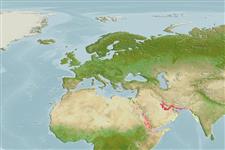Environment: milieu / climate zone / depth range / distribution range
Ecologie
marien demersaal; diepte 0 - 6 m (Ref. 10683). Tropical
Western Indian Ocean: Gulf coast of Saudi Arabia and central coast of Oman.
Grootte / Gewicht / Leeftijd
Maturity: Lm ? range ? - ? cm
Max length : 3.5 cm SL mannelijk / geslacht onbekend; (Ref. 10683)
Dorsale stekels (totaal): 7; Dorsale zachte stralen (totaal): 10-11; Anale stekels 1; Anale zachte stralen: 9 - 10; Wervels: 27. Most similar to C. anomolus meristically and in color pattern, but readily separated by having united instead of separate pelvic fins and modally 9 instead of 10 anal soft rays.
Specimens collected from protected waters; sand to gravel substrate, with some rock, algae, or seagrass (Ref. 11441).
Levenscyclus en paargedrag
Maturiteit | Voortplanting | Paaien | Eieren | Fecunditeit | Larven
Randall, J.E., 1994. A new genus and six new gobiid fishes (Perciformes: Gobiidae) from Arabian waters. Fauna Saudi Arabia 14:317-340. (Ref. 10683)
Status op de Rode Lijst van het IUCN (Ref. 130435)
Gevaar voor de mens
Harmless
Gebruik door de mens
Meer informatie
Lokale namenSynoniemenMetabolismePredatorenEcotoxicologieVoortplantingMaturiteitPaaienPaaiaggregatiesFecunditeitEierenOntwikkeling van de eieren
ReferentiesAquacultuurAquacultuurprofielKweeklijnenGeneticaElectrophoresesErfelijkheidZiektesVerwerkingNutrientsMassaconversie
Tools
Speciale rapporten
Download XML
Internetbronnen
Estimates based on models
Preferred temperature (Ref.
123201): 25.7 - 29.2, mean 27.6 °C (based on 345 cells).
Fylogenetische diversiteitsindex (Ref.
82804): PD
50 = 0.5002 [Uniqueness, from 0.5 = low to 2.0 = high].
Bayesian length-weight: a=0.00708 (0.00333 - 0.01504), b=3.09 (2.92 - 3.26), in cm total length, based on LWR estimates for this (Sub)family-body shape (Ref.
93245).
Trofisch niveau (Ref.
69278): 3.1 ±0.3 se; based on size and trophs of closest relatives
Weerstandsvermogen (Ref.
120179): Hoog, minimale populatieverdubbelingstijd minder dan 15 maanden (Preliminary K or Fecundity.).
Fishing Vulnerability (Ref.
59153): Low vulnerability (10 of 100).
